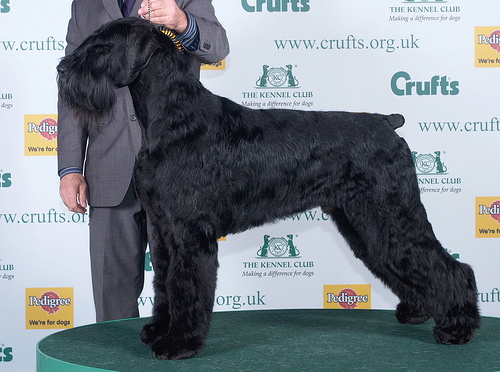

Giant Schnauzers
The Giant Schnauzer is a large, powerful, and compact
breed of dog. It is one of the three Schnauzer breeds. Like most large breeds,
the Giant Schnauzer needs a fair amount of exercise.
Appearance
When hand-stripped, the Giant Schnauzer has a harsh, wiry outer coat and dense,
soft undercoat. Coat color is either black or salt and pepper (grey). It weighs
between 70 and 100 lb (32 to 45 kg) and stands 23.5 to 27.5 in (59 to 70 cm) at
the withers.When moving at a fast trot, a properly built Giant Schnauzer will
single-track. Back remains strong, firm, and flat.
The American Kennel Club lists the Giant as low shedding - and therefore
hypoallergenic - along with both other breeds of Schnauzers. However, Giant
Schnauzers, as with almost all dogs, do shed. When allowed, the hair on a
Schnauzer will grow long, which increases shedding, and thereby potentially
increasing allergens. This can be mitigated with consistent grooming to include
mostly Long hair. The Giant Schnauzer does not moult.
Temperament
The Giant Schnauzer is a great dog if one is looking for a playful yet guarding
protector. For those who like the large dogs, the size of the Giant can be very
discouraging for any would-be offender, but it is not necessarily a Gentle Giant
as say the Great Dane. Some tend to have a herding instinct at a young age so it
is best to teach puppies or younger dogs to not nip or mouth at all. In many
cases it has lead to the dog going straight back to the breeder or worse, a
shelter. Some Giants can be dog aggressive, but that is common with all
Schnauzers. Socialize, socialize, and socialize as much as you can when you can
they will be modeled companions.

Don't, and one will have themselves a problem of
a dog who's possibly 100 lbs. + snapping at other dogs which can lead to legal
trouble. Some have even shown aggression to just female sexes.
This is a working breed and such requires some amount of exercise or troubling
behaviors may occur to relinquish that bored state they may have. A good jog or
a let loose in a park with other dogs and maybe a water source will give the
owner a well-mannered and tired friend coming home. They are a water breed,
which means unless the owner wants to give a bath after their dog has been
soaking in a well filled ditch or pond, proper training will be needed or Giants
will jump head first into any body of water to swim and even drink.
They are not a breed that will take off the moment one
lets them off the leash. Some will even turn back mid-stride to make sure their
owner is near and may even turn back if too far away. This is not to say to let
a dog off in an open park as there are of course risks, especially with leash
laws, but they are a distinguishing breed then most that would take off and not
look back. Using caution will minimize the risk.
The Giant has received four stars out of five on protection. They will let their
owner know a car or even footsteps approaching the house far before a human
would identify. They have a sort of howling bark that makes them sound larger
than life to said-offenders and that in itself will probably do the trick. If
not, one will have a dog that upon the slightest hint of an attack will launch
itself in soaring fashion at the offender.

Due to their terrier heritage they will shake whatever
part of the body they latch onto which no doubt will cause the intruder who was
looking for an easy will pick to leave limping. However, such a protective
nature may lead to people aggression if not properly socialized. This is not a
dog to stick in the backyard and leave it at that. Acquaintances, friends and
even family members can find themselves on the wrong end of the Giant's massive
mouth which will lead to much bigger legal problems if blood is drawn. Proper
training and socialization will have this particular breed at one's side as a
well-mannered companion.
The Giant Schnauzer is a powerful breed that demands a steady, yet very gentle
hand and with proper leadership, this large breed can not only be a couch
companion and jogging partner, but a loyal and a not too overprotective friend
that will take a bullet for its owner.
Health problems
Health problems in the breed include:
• Autoimmune diseases (hypothyroidism, Autoimmune hemolytic anemia (AIHA) (also
called Immune Mediated Hemolytic Anemia (IMHA)), SLO, Crohn's disease, and so
on)
• Epilepsy
• Hip dysplasia
• Incontinence
• Toe Cancer
History
The breed has been described as far back as 1832 from cattle and pig farms in
the Bavarian highlands region of Germany and has been called oblanders, although
a written breed standard was not established until 1923. It was at this time
(breed description and showing of these dogs) that some breeders used standard
schnauzers to help fix the schnauzer type and developed the central German type
Giant Schnauzer. The Munich type and oblanders were used for power and size.
After World War I, the Giant Schnauzer was significantly reduced in numbers. The
Kennel (Kinzigtal) owned by C. Clalaminus, contributed to reestablishing the
breed. It was this kennel that admitted to three crosses to dogs of other breeds
to assist with dominate black color, well-crested neck and correct head
proportions. It is speculated that black Great Dane, and or the Bouvier des
Roulers may have been the breed of the three unknown crosses. Still the
foundation stock was oblanders to which oversize standard schnauzers were added.